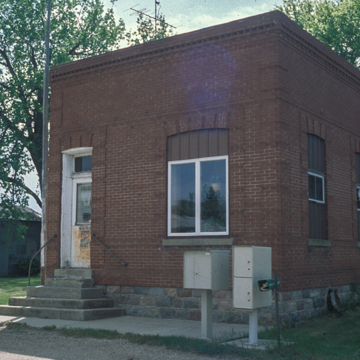At its peak in the 1920s, Manfred had a population of approximately four hundred. Today, Manfred is a village of about ten people, with Vang Lutheran Church (WE5) and two grain elevators being the only remaining active entities. However, the community has restored several of the buildings and created a culture of heritage tourism. The Hotel Johnson (1906), built by Nennie Johnson, was patronized by passengers traveling on the Soo Line railroad. In 1908 Johnson sold the hotel—it was renamed the Manfred Hotel— and also that year, he built the pressed-metal-clad Manfred Cash Store (later the Peterson General Store) and operated a barbershop and recreation parlor there until about 1921. Thomas Lincoln Bieseker (see WE2) was founder and president of the First State Bank of Manfred (1903), an extension of his Fessenden banking interests. The two-bay bank has a fieldstone foundation and brick arches and quoins. Taken over by the State Guaranty Bank of Harvey in 1925, the Manfred bank was dissolved in that year.
You are here
Manfred Historic District
If SAH Archipedia has been useful to you, please consider supporting it.
SAH Archipedia tells the story of the United States through its buildings, landscapes, and cities. This freely available resource empowers the public with authoritative knowledge that deepens their understanding and appreciation of the built environment. But the Society of Architectural Historians, which created SAH Archipedia with University of Virginia Press, needs your support to maintain the high-caliber research, writing, photography, cartography, editing, design, and programming that make SAH Archipedia a trusted online resource available to all who value the history of place, heritage tourism, and learning.


